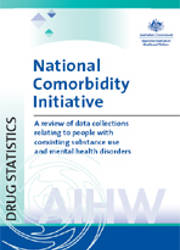Summary
This project identifies, reviews and reports on the current state of data collections relating to people with coexisting substance use and mental health disorders (‘comorbidity’) in Australia.
Background (see Chapter 1)
The Australian Government, under the National Illicit Drug Strategy, allocated $9.7 million over five years to a National Comorbidity Initiative to improve service coordination and treatment outcomes for people with coexisting mental health and substance use disorders. One priority under this Initiative is to improve data systems and collection methods within the mental health and alcohol and other drug sectors to manage comorbidity more effectively. The Australian Government Department of Health and Ageing (DoHA) commissioned the Australian Institute of Health and Welfare (AIHW) to undertake this project to inform this priority area.
Process (see Chapters 2–6)
At the outset of the project, a project advisory group (comprising representatives from the AIHW, DoHA and the Australian Institute of Criminology) was established to provide expert advice to the project team throughout the duration of this work.
The first stage of the project focused on current literature within the field, previous work commissioned under the National Comorbidity Initiative, as well as the National Mental Health Plan (2003–2008) and the National Drug Strategy (2004–2009) to gain a more comprehensive understanding of what stakeholders want and need to know about people with comorbidity in Australia. From this, a list of key questions relating to comorbidity was identified.
During the second stage of the project, 56 data collections in the areas of mental health, alcohol and other drugs, general health and/or welfare, housing, income support, criminal justice and child protection, and education and training were explored, in the first instance to determine whether they were of relevance to the issue of comorbidity, and therefore this project. Of these, 38 data collections (‘key data sources’) were identified as being relevant and able to inform the understanding of comorbidity in Australia. A comparative analysis was then undertaken of the key data sources, comparing them in terms of their methodology, scope, coverage, timing, collection counts and data items. The key data collections were then related back to the key questions about comorbidity, to determine the extent to which the data collections could currently answer them.
Exploring the comparability of key data collections and attempting to answer the key questions about comorbidity revealed a number of gaps and areas for improvements in existing data collections. Options for improving the usefulness and availability of information about people with comorbidity in Australia are then discussed.
The current state of play (see Chapter 5)
The key data sources provide information which would enable analysts to address, to varying extents, the majority of the key questions relating to comorbidity. For example, with appropriate methodology, the key data sources provide information to describe comorbidity in the Australian population (in various demographic subgroups and settings) and the many types of services accessed by this group. However, current data sources are not able to fully address questions about service delivery models and outcomes for people with comorbidity.
The extent to which the data sources are capable of addressing these questions depends partly on their comparability in terms of factors such as methodology, definitions and classifications. Before attempting to use the data sources to address research questions, analysts would need to consider these and a number of other issues, including sample size and data quality.
Future possibilities (see Chapter 6)
Australia is currently in the relatively privileged position of having a rich set of data sources relating to the issue of comorbidity. While in most cases the reviewed data sources provide information that contributes towards an understanding of comorbidity, these collections were not designed to specifically address all questions about comorbidity. It may be possible in the future, and in cooperation with the stakeholders responsible for these data sources, to improve the usefulness of existing data. A number of suggestions for such improvements, together with options for future analysis, are highlighted.
Preliminary material: Lists of tables and appendix collection summaries; Acknowledgments; Abbreviations
1. Introduction
- Purpose of project
- Scope of project
- Analytical framework for the assessment of data collections
2. What are the key questions and information needs in relation to comorbidity?
- Literature review
- Key questions highlighted in literature
3. Data sources relating to comorbidity
- Relevant data sources
- Descriptions of relevant data sources
- Key data sources
4. Comparative analysis of key data sources
- Comparability of key data sources in terms of methodology, scope, coverage, timing and collection counts
- Comparability of key data sources in terms of data items
5. Answering the key questions in relation to comorbidity
- To what extent can the key questions be answered?
6. Improving information about comorbidity
- Improving usefulness of existing data
- Improving the analytical power of existing data
- Future possibilities
- Dissemination
- Conclusion
Appendix: Collection summaries
End matter: References



